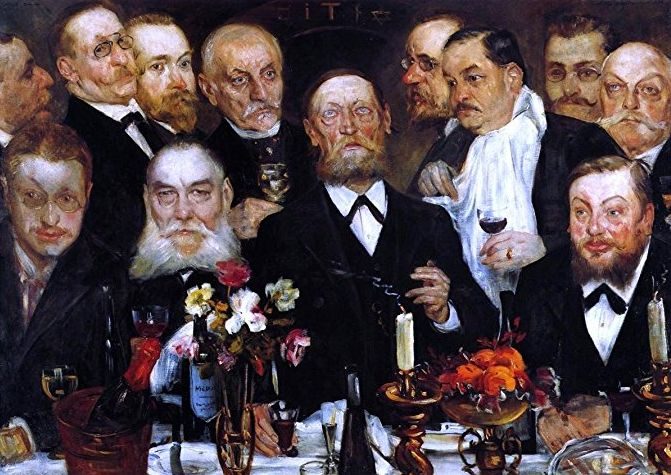Once in every year, on a specific date, each Masonic Lodge selects from its skilled Brethren a Mason who will officiate in the capacity of Master. The process of the installation comprises three parts. To begin with, the candidate has to come out the winner from a ballot; then he has to swear to conscientiously discharge his duties and uphold the principles of the Craft. Finally, the departing Master installs him in the Chair of King Solomon. With that achieved, the new Master concentrates on investing his Principal and Assistant Officers with the collar and tools of their Station. The Tyler is among those Officers and his place is outside the door of the Lodge because, as his title implies, he has “to tile” i.e. to cover, protect and conceal. The Master will invest him by reciting these words: “(…) your duty consists of keeping off all Cowans and eavesdroppers to Freemasonry and ensure that none shall pass save those who are duly qualified”. He then explains to the congregation the symbolical teaching of the sword and hands the tool to the Tyler. Let us now consider the two characters that the Master mentions to the Tyler.
achieved, the new Master concentrates on investing his Principal and Assistant Officers with the collar and tools of their Station. The Tyler is among those Officers and his place is outside the door of the Lodge because, as his title implies, he has “to tile” i.e. to cover, protect and conceal. The Master will invest him by reciting these words: “(…) your duty consists of keeping off all Cowans and eavesdroppers to Freemasonry and ensure that none shall pass save those who are duly qualified”. He then explains to the congregation the symbolical teaching of the sword and hands the tool to the Tyler. Let us now consider the two characters that the Master mentions to the Tyler.
In the Middle Ages the eavesdropper was a person who spied by hiding in the eaves, i.e. a part of the roof that meets or overhangs the face of a wall in an building. 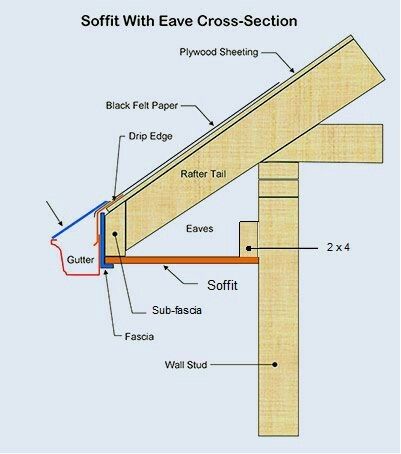 But the changes in style and technique that the art of construction has undergone through the course of the centuries, have rendered this now nigh improbable. We have in consequence come to identify the eavesdropper as that individual who stands by the door of a chamber or leans onto a partition wall, to carry out his [1] devious design. Yet this was just the kind of sneaky work that centuries ago defined the Cowan! His description reads: “a person who lurked under the window (s) of people’s homes and who carried the overheard conversation from neighbour to neighbour, to the
But the changes in style and technique that the art of construction has undergone through the course of the centuries, have rendered this now nigh improbable. We have in consequence come to identify the eavesdropper as that individual who stands by the door of a chamber or leans onto a partition wall, to carry out his [1] devious design. Yet this was just the kind of sneaky work that centuries ago defined the Cowan! His description reads: “a person who lurked under the window (s) of people’s homes and who carried the overheard conversation from neighbour to neighbour, to the 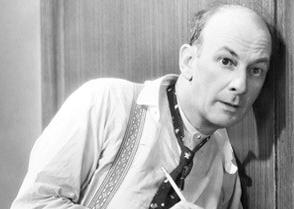 great disquiet of many.” Through the ages, those two separate figures appear to have blended into one.
great disquiet of many.” Through the ages, those two separate figures appear to have blended into one.
The often cowardly nature of the eavesdropper means that the Tyler often meets no difficulty in escorting him away from the lobby of the Lodge,when he catches one in action. And should the Tyler fail to be on his guard, the suffering that the eavesdropper could bring to Freemasonry only consists in capturing masonic secrets that are audible to him. The Cowan, in Freemasonry, however, is altogether another matter. He is from a difference plane of jeopardy and attacks a more serious vulnerability.
Bernard E. Jones, in his “Freemasons’ guide and compendium”, calls the Cowan “the most misunderstood of all characters mentioned in the Masonic ritual”. This is certainly the case and not just Masonically speaking. The reason the Cowan is a misunderstood character lays in there being two of them! The historical Cowan – who is the builder from the ancient operative Masonry – and the figurative Cowan of our modern and speculative Freemasonry whose profiles are partly listed in this paper.
THE COWAN IN OPERATIVE FREEMASONRY
The term “Cowan” first appeared in an official English Masonic document in 1738, when the Scottish Freemason Dr James Anderson introduced it into his Constitutions which state that “free and accepted masons shall not allow Cowans to work with them; nor shall masons be employed by Cowans without an urgent necessity and even in that case, they must not teach Cowans, but must have a separate communication with them”.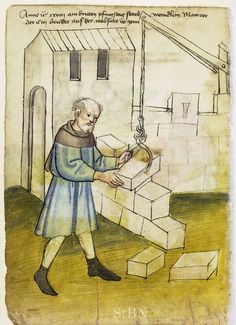
The French language dictionary has two terms from which “Cowan” may derive: coion and coin. The former is improbable because the word defines a base fellow, the latter means corner. It is thus conceivable that an alteration of coin was applied in England to call a craftsman who worked solely on cornerstones of buildings, but who was not qualified to go any further than that in terms of construction.
In the Scottish operative Freemasonry, we find that Cowan was a name used to identify a “dry-dyker” or “dry waller”. This was a builder, principally of boundary walls, whose technique consisted in keeping a structure together only by the stones’ own weight instead of by the use of the mortar. In testimony of the existence of those Cowans and of the style of their work, we can still find throughout Scotland tower structures called “broch” – see one in the picture below – which they built centuries ago using the simple method described 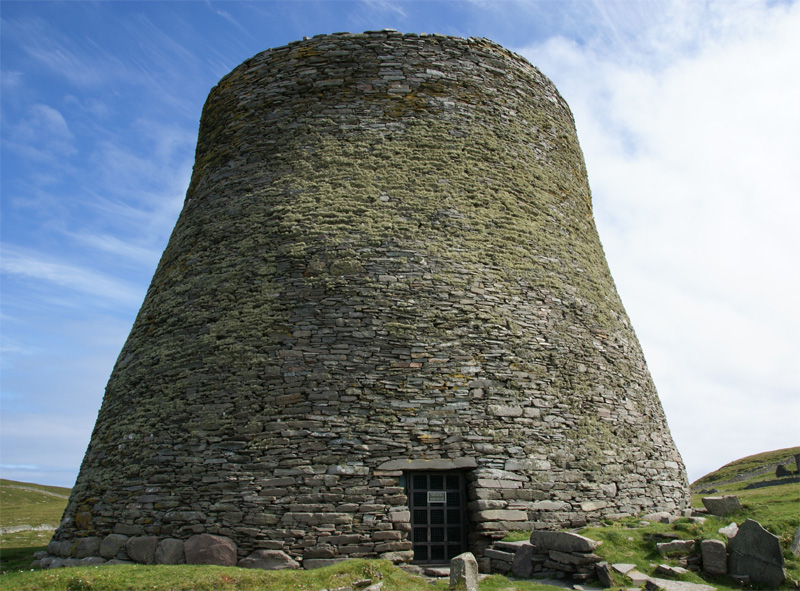 earlier. The walls of those structures are concentric, with the inner ones being perpendicular and the outer ones being bell-shaped.
earlier. The walls of those structures are concentric, with the inner ones being perpendicular and the outer ones being bell-shaped.
The Cowan, could have been a builder who had learned the craft in an imperfect or irregular way. Perhaps he had never finished his full trade apprenticeship – whether due to his fault or that of his master – and had migrated from the countryside into town in pursuit of employment. However, by not being a member of the Masonic Fraternity, he would have only found low-skilled employment.
Robert Gould[2] in his History of Freemasonry reported that the ancient Scottish Lodge of Kilwinning – which holds records from 1599 right up to 1736 [3] – considered the Cowan to be a skilled worker who did not have the secret word of recognition adopted by the Freemasons. The minute of a meeting held in 1707 states that “no Mason shall employ a Cowan – which is to say someone without the word to work”. In December 1646 and again in January 1656 [4], the Lodge had indeed fined Brother Hew Mure ten pounds for working with Cowans.
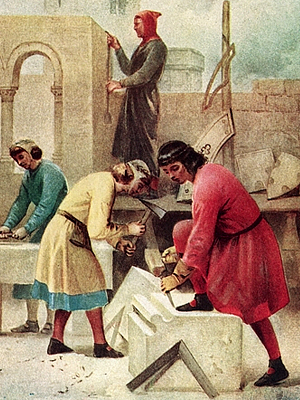 In a move to put an end to the threat that those semi-skilled country builders represented, and to prevent the labour market being swamped by cheap labour, the city Guilds adopted for their members, signs and words of recognition. In Scotland however some Lodges chose not to exclude a Cowan from taking part in their meetings and there were even cases when Cowans received the password and became fully regular Masons. For example, the Cannongate Lodge in 1668 admitted John Sim and depicted him in the minutes as “an honest old man and a Cowaner”. And the Lodge of Kilwinning itself authorized the employment of Cowans for any kind of work when no “regular” craftsmen was available within a perimeter of 15 miles! The minutes of the Kilwinning Lodge dated 1 July 1599 recorded[5] that Brother George Patoun breached his lodge’s statute and that he vexed his Deacon, Warden and Master Masons by employing: “ane (one) Cowan to work at ane chymnay heid”.
In a move to put an end to the threat that those semi-skilled country builders represented, and to prevent the labour market being swamped by cheap labour, the city Guilds adopted for their members, signs and words of recognition. In Scotland however some Lodges chose not to exclude a Cowan from taking part in their meetings and there were even cases when Cowans received the password and became fully regular Masons. For example, the Cannongate Lodge in 1668 admitted John Sim and depicted him in the minutes as “an honest old man and a Cowaner”. And the Lodge of Kilwinning itself authorized the employment of Cowans for any kind of work when no “regular” craftsmen was available within a perimeter of 15 miles! The minutes of the Kilwinning Lodge dated 1 July 1599 recorded[5] that Brother George Patoun breached his lodge’s statute and that he vexed his Deacon, Warden and Master Masons by employing: “ane (one) Cowan to work at ane chymnay heid”.
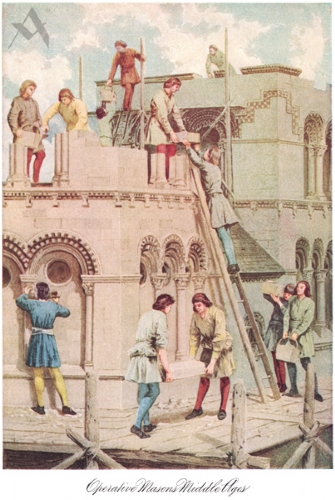 With the introduction of words and signs of recognition among Freemasons, the Guilds became monopolies and confined the Cowans to the verge of the building trade. They were thus never allowed to fully learn the skills needed to erect those wonderful stone structures, like the medieval Cathedrals, that we all admire even today.
With the introduction of words and signs of recognition among Freemasons, the Guilds became monopolies and confined the Cowans to the verge of the building trade. They were thus never allowed to fully learn the skills needed to erect those wonderful stone structures, like the medieval Cathedrals, that we all admire even today.
In this context it would be wrong and prejudiced to use “Cowan” as a term of opprobrium, contempt or reproach.
THE COWAN IN SPECULATIVE FREEMASONRY
Through the course of the ages, the Operative Freemasonry released its secrets to the world and left the mysteries of the moral building to the Speculative Freemasonry. The latter, therefore, considers in theory what the operative builder puts to practice and it uses the tools of those workmen as emblems in the construction of a speculative temple. The Masonic ritual reads: “(…) as we are not Operative Masons but Free and Accepted or Speculative Masons, we apply these tools to our morals”. With some variations, the Freemasons repeat these words in each of the Craft Degrees when presenting the working tools and we notice their analogies also in Degrees of a few sides Orders. Mark Masonry is one.
Like the Cowan of long ago, a modern-day Cowan is not an evil or violent individual, nor does he wish to destroy Freemasonry or is interested in stealing its secrets. For the speculative Freemasonry the Cowan is a symbolic representation of all those things which can hinder man’s spiritual growth. The Cowan, therefore, can be a stranger as well as a Freemason himself. He can be, for example, that Freemason who scorns the Craft because he is resentful or has differing opinions and whom we shall call an “anti-mason”.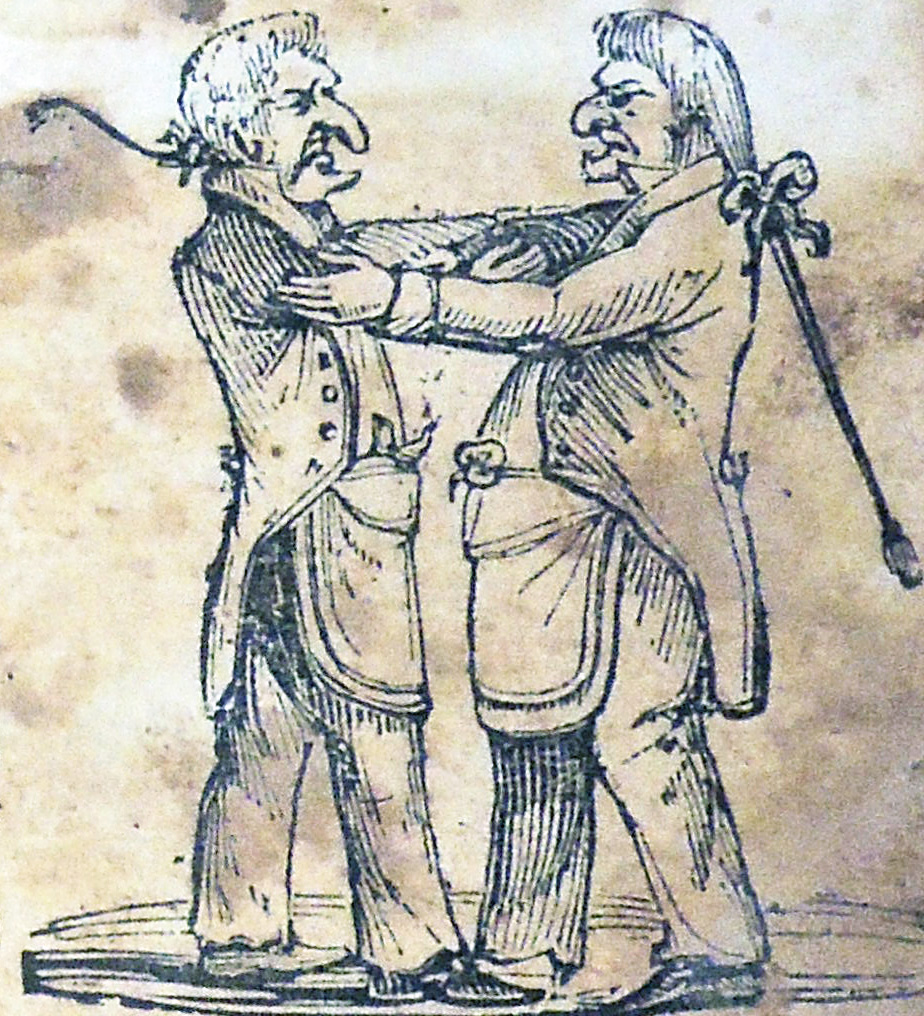
A Cowan can be the slanderer who makes malicious claims about the activities and the purpose of Freemasonry, or an individual who spreads unfounded stories of devil-worshipping and world domination by the Order. The anti-mason talks of Masonic conspiracies and bends parts of the ritual to support absurd theories. He is a reviler of religion and may bend towards avarice, injustice, malice or revenge.
Although the vast majority of Freemasons are upright and generous men, it is indisputable that the Order–which spreads over the “four quarters of the globe” – also harbours questionable and immoral individuals, business opportunists and even criminals. Some people join the Craft out of curiosity or in the unfounded belief they may obtain a higher status in society ; others want recognition and prestige by being members of an organisation they envy.
The figurative Cowan is the vain Brother who, ignorant of the most basic Masonic teaching, joins various side orders and wears their multi coloured aprons, collars and worthless medals to satisfy his Ego.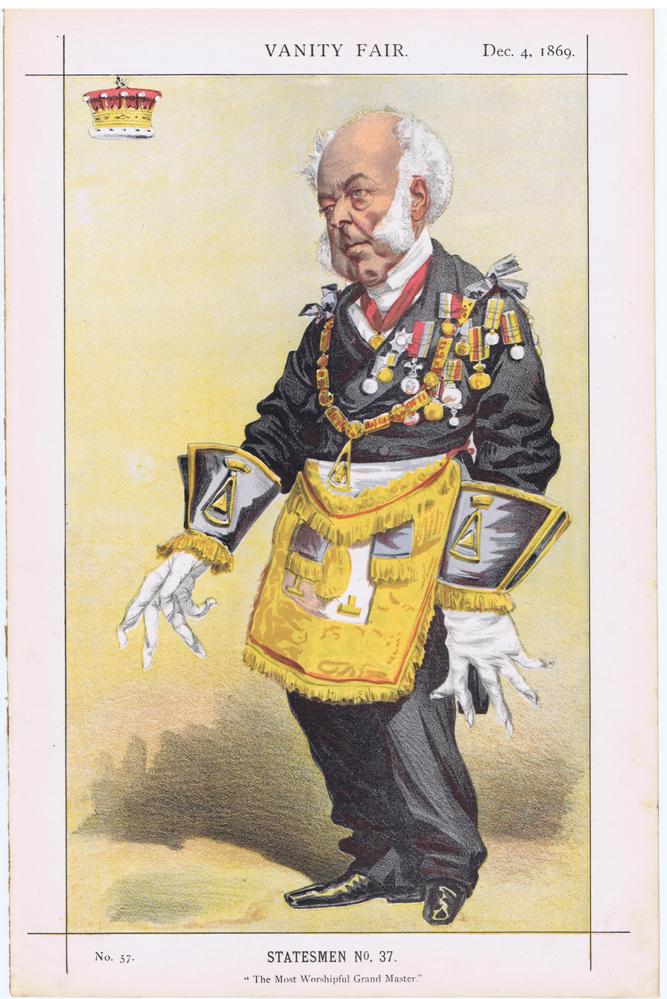 The figurative Cowan can also be that social misfit who has made more foes than friends in the outside world and who comes to Freemasonry only to seek a safe heaven. Or it could be the Brother who entices into the Order his buddy,
The figurative Cowan can also be that social misfit who has made more foes than friends in the outside world and who comes to Freemasonry only to seek a safe heaven. Or it could be the Brother who entices into the Order his buddy,  colleague, family member only to gain in consideration in the eyes of his superiors. They, in turn, commit the crime of sacrificing on the altars of numbers, of office progression and honorifics, the serious scrutiny of the applicant’s moral character and inclination. “Go forth and multiply” is the general outcry, but we must not substitute the “worthy and well-recommended candidate” either with the stranger plucked from the street pavement nor with whomsoever wants to join Freemasonry on a whim.
colleague, family member only to gain in consideration in the eyes of his superiors. They, in turn, commit the crime of sacrificing on the altars of numbers, of office progression and honorifics, the serious scrutiny of the applicant’s moral character and inclination. “Go forth and multiply” is the general outcry, but we must not substitute the “worthy and well-recommended candidate” either with the stranger plucked from the street pavement nor with whomsoever wants to join Freemasonry on a whim.
The figurative Cowan is also the Brother whose candidature the Lodge has endorsed 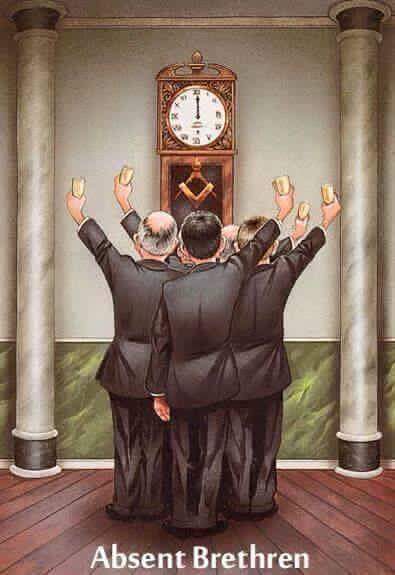 only for his social – instead of moral! – standing , his useful and enviable trade or, worse, for an economic argument. Inevitably and in time , such candidate becomes disenchanted and joins the queue of the absent or unlodged masons. The figurative Cowan is also the Brother who, in terms of worthiness, puts the festive board above all else because for him the whole evening is just a social event!
only for his social – instead of moral! – standing , his useful and enviable trade or, worse, for an economic argument. Inevitably and in time , such candidate becomes disenchanted and joins the queue of the absent or unlodged masons. The figurative Cowan is also the Brother who, in terms of worthiness, puts the festive board above all else because for him the whole evening is just a social event!
We call that Brother the dining-mason. 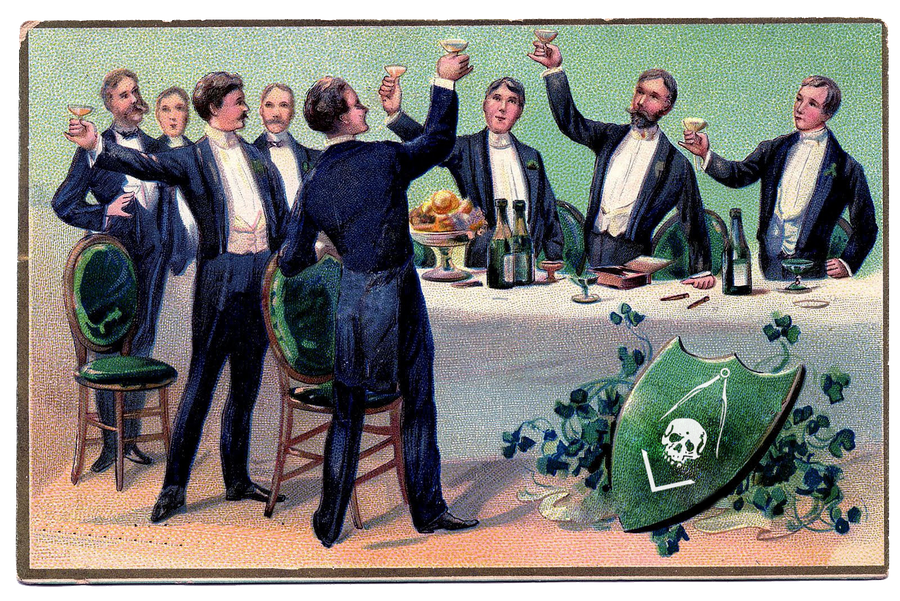
The list could go on but, in closing, the figurative Cowan is the Mason who for all the faults mentioned earlier – and no doubt for many other ones that I have left out – can be more of a threat to Freemasonry than the intruder who should prompt the Tyler to swing his sword!
Remember that just as a Cowan of centuries ago could never erect a perfect structure because he did not know how to use the mortar, so the Cowan of today cannot build the temple of his life without knowledge, faith and belief in spiritual values.
By admitting Cowans in our midst, we diminish Freemasonry and we fail ourselves.
By A. Nowac
The author forbids any reproduction or publication of this article, in full or in part, without his explicit authorisation.
[1] The feminine “her” would not be considered out of place in this context. Read about the cases of Elizabeth St Leger and Isabella Scoon who were caught eavesdropping into Masonic meetings. They are mentioned in the paper “The Chevalier D’Eon, the first transgender Freemason”
[2] Robert Freke Gould (10.11.1836-26.3.1915) was a soldier, barrister and prominent Freemason and Masonic historian. He wrote a History of Freemasonry (3 volumes) which remains a standard reference work on the subject.
[3] The year when the Grand Lodge of Scotland was established
[4] The Secret of Freemasonry by WB Robert Lomas, page 98, 2006 edition
[5] The Secret of Freemasonry by Robert Lomas, page 109, 2006 edition
SOURCES
The Masonic Trowel , 2014 issue
“The Anti-Mason” by W Bro Mike Martin , Mersey Lodge 5434 – Pietre-Stones internet publication
“Freemasons’s Guide and Compendium” by Bernard E. Jones
“The Secret of Freemasonry” by WB Robert Lomas
- Influencia de la Masonería en Chile - April 29, 2024
- Pomegranate in Freemasonry – its significance - March 11, 2024
- Inns and Innkeepers’ incidence in Freemasonry expansion - February 28, 2024

